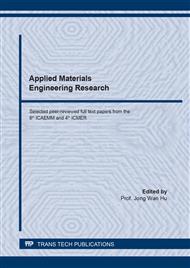[1]
E. S. Abd El-Sayed, M. El-Sakhawy, M. A. M. El-Sakhawy, Non-wood fibers as raw material for pulp and paper industry, Nord Pulp Paper Res J. 35(2) (2020) 215-230.
DOI: 10.1515/npprj-2019-0064
Google Scholar
[2]
G. Huang, J. X. Shi, T. A. Langrish, A new pulping process for wheat straw to reduce problems, Bioresour. Technol. (2007) 2829–2835.
DOI: 10.1016/j.biortech.2006.09.029
Google Scholar
[3]
A.K. Das, A.N. Izumi, H. Ohi, Quality evaluation of dissolving pulp fabricated from banana plant stem and its potential for biorefinery, Carbohydr. Polym. 147 (2016) 133-138.
DOI: 10.1016/j.carbpol.2016.03.103
Google Scholar
[4]
A. Baharin, N. A. Fattah, A. A. Bakar, Z. M. Ariff, Production of laminated natural fibre board from banana tree wastes, Procedia Chem. 19 (2016) 999–1006.
DOI: 10.1016/j.proche.2016.03.149
Google Scholar
[5]
A. Ramdhonee, P. Jeetah, Production of wrapping paper from banana fibres, J. Environ. Chem. Eng. 5(5) (2017) 4298–4306.
DOI: 10.1016/j.jece.2017.08.011
Google Scholar
[6]
H. Tran, E. K. Vakkilainen, The kraft chemical recovery process, Tappi Kraft Pulping Short Course. (2016) 1-8.
Google Scholar
[7]
T. Ferdous, M. A. Quaiyyum, M. S. Jahan, Chlorine dioxide bleaching of nineteen non-wood plant pulps, Nord Pulp Paper Res J. 35(4) (2020) 569-576.
DOI: 10.1515/npprj-2020-0043
Google Scholar
[8]
M. Mamaye, Z. Kiftie, S. Feleke , A. Yimam, Evaluation of soda delignification and single-stage hydrogen peroxide bleaching for the Ethiopian sugarcane bagasse for paper production, Sugar Tech. (2020) 706-717.
DOI: 10.1007/s12355-019-00793-y
Google Scholar
[9]
A. Mathur, N. Andersson, D. Smith, R. Onofre, G. Morgan, Bleach plant optimization utilizing novel measurement technologies complemented with advanced process control. O Papel. 79 (2018) 65-72.
Google Scholar
[10]
S. Sutradhar, M. Sarkar J. Nayeem, M. Sarwar Jahan, C. Tina, Potassium hydroxide pulping of four non-woods, Bangladesh j. sci. ind. res. (2018) 1-6.
DOI: 10.3329/bjsir.v53i1.35903
Google Scholar
[11]
A. L. S. Pereira, D. M. Nascimento, M. de S. M. Souza Filho, A. R. Cassales, et al., Banana (Musa sp. cv. Pacovan) Pseudostem Fibers are Composed of Varying Lignocellulosic Composition throughout the Diameter. BioResources, 9(4) (2014) 7749-7763.
DOI: 10.15376/biores.9.4.7749-7763
Google Scholar
[12]
F. Sameer, Z. Sabia, A.Q. Rather, A. Tahir, Characterization and evaluation of banana waste (Musa paradisiac L.) as a raw material for paper production, Int. J. Environ Bioener. 4(1) (2012) 1-7.
Google Scholar
[13]
K. Arafat, J. Nayeem, A. Quadery, M. Quaiyyum, M. S. Jahan, Handmade paper from waste banana fibre. Bangladesh j. sci. ind. res. 53(2) (2018) 83-88.
DOI: 10.3329/bjsir.v53i2.36668
Google Scholar
[14]
G. Huang, C. Chengfang, Z. Chen, Pulping of wheat straw with caustic potash-ammonia aqueous solutions and its kinetics, Chinese J. Ch. E. 14(6) (2006) 729.
DOI: 10.1016/s1004-9541(07)60003-2
Google Scholar
[15]
C. Loix, M. Huybrechts, J. Vangronsveld, M. Gielen, E. Keunen, A. Cuypers, Reciprocal interactions between cadmium-induced cell wall responses and oxidative stress in plants, Front. Plant Sci. 8 (2017) 1-19.
DOI: 10.3389/fpls.2017.01867
Google Scholar
[16]
R Wathén, Studies on Fiber Strength and Its Effect on Paper Properties. Helsinki University of Technology, Doctoral dissertation, Ph. D. Thesis. (2006).
Google Scholar
[17]
R. Chandrakala, P. Gundev, L. Singh, L, Effect of Different Spices on Enzymatic Browning of Banana Pseudostem Juice, JSRR. (2017) 1-7.
DOI: 10.9734/jsrr/2017/37919
Google Scholar
[18]
T. Ferdous, M. A. Quaiyyum, Y. Jin, M. S. Bashar, K. M. Y. Arafat, M. S. Jahan, Pulping and bleaching potential of banana pseudo stem, banana leaf and banana peduncle, Biomass Conv. Bioref. (2021) 1-12.
DOI: 10.1007/s13399-020-01219-6
Google Scholar


